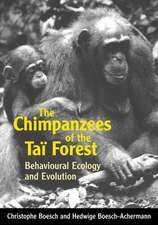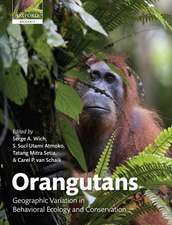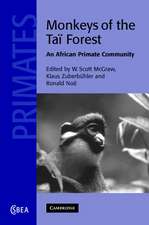Primate Males: Causes and Consequences of Variation in Group Composition
Editat de Peter M. Kappeleren Limba Engleză Paperback – 3 mai 2000
Preț: 385.10 lei
Nou
Puncte Express: 578
Preț estimativ în valută:
73.69€ • 77.13$ • 61.33£
73.69€ • 77.13$ • 61.33£
Carte tipărită la comandă
Livrare economică 31 martie-14 aprilie
Preluare comenzi: 021 569.72.76
Specificații
ISBN-13: 9780521658461
ISBN-10: 0521658462
Pagini: 328
Ilustrații: 74 b/w illus. 43 tables
Dimensiuni: 190 x 247 x 21 mm
Greutate: 0.68 kg
Ediția:New.
Editura: Cambridge University Press
Colecția Cambridge University Press
Locul publicării:Cambridge, United Kingdom
ISBN-10: 0521658462
Pagini: 328
Ilustrații: 74 b/w illus. 43 tables
Dimensiuni: 190 x 247 x 21 mm
Greutate: 0.68 kg
Ediția:New.
Editura: Cambridge University Press
Colecția Cambridge University Press
Locul publicării:Cambridge, United Kingdom
Cuprins
Preface; Part I. Introduction: 1. The socioecology of primate males: history and theory Peter M. Kappeler; Part II. Comparative Perspectives on Male-Female Association: 2. Multi-male breeding groups in birds: ecological causes and social conflicts Nick B. Davies; 3. Males in macropod society Peter Jarman; 4. Social counterstrategies against infanticide by males in primates and other mammals Carel van Schaik; Part III. Variation in Male Numbers: Taxon-Level Analyses: 5. Causes and consequences of unusual sex ratios in lemurs Peter M. Kappeler; 6. The number of adult males in callitrichine groups and its implications for callitrichine social evolution Eckhard W. Heymann; 7. From binding brotherhoods to short-term sovereignty: the betwixting dilemma of male Cebidae Karen B. Strier; 8. The number of males in guenon groups Marina Cords; 9. Socioecology of baboons: the interaction of male and female strategies Robert A. Barton; 10. Variation in adult sex ratios of red colobus monkey social groups: implications for interspecific comparisons Thomas T. Struhsaker; 11. The number of males in langur groups: monopolizability of females or demographic process? Elisabeth H. M. Sterck and Jan A. R. A. M. van Hooff; 12. Costs and benefits of the one-male, age-graded and all-male phase in wild Thomas langur groups Romy Steenbeek, Elisabeth H. M. Sterck, Han de Vries and Jan A. R. A. M. van Hooff; 13. Male dispersal and mating season influxes in Hanuman langurs living in multi-male groups Carola Borries; 14. Rethinking monogamy: the gibbon case Volker Sommer and Ulrich Reichard; 15. Causes and consequences of variation in male mountain gorilla life histories and group membership David P. Watts; Part IV. Behavioural Aspects of Male Coexistence: 16. Relationships among nonhuman primate males: a deductive framework Jan A. R. A. M. van Hooff; 17. Collective benefits, free-riders and male extragroup conflict Charles L. Nunn; 18. Dominance, egalitarianism and stalemate: an experimental approach to male-male competition in Barbary macaques Signe Preuschoft and Andreas Paul; Part V. Evolutionary Determinants and Consequences: 19. The evolution of male philopatry in neotropical monkeys Theresa Pope; 20. Models of outcome and process: predicting the number of males in primate groups Jeanne Altmann; 21. Why are male chimpanzees more gregarious than mothers? A scramble competition hypothesis Richard W. Wrangham; 22. Male mating strategies: a modeling approach Robin I. M. Dunbar; Part VI. Conclusions: 23. Understanding male primates Michael E. Pereira, Timothy H. Clutton-Brock and Peter M. Kappeler; References; Index.
Recenzii
"This technical compendium will generate much debate in seminars and journals during the coming decade. Recommended for anthropological and zoological collections." Choice
Descriere
Explores male number variation between and within primate species and its effects on male-female relationships.









